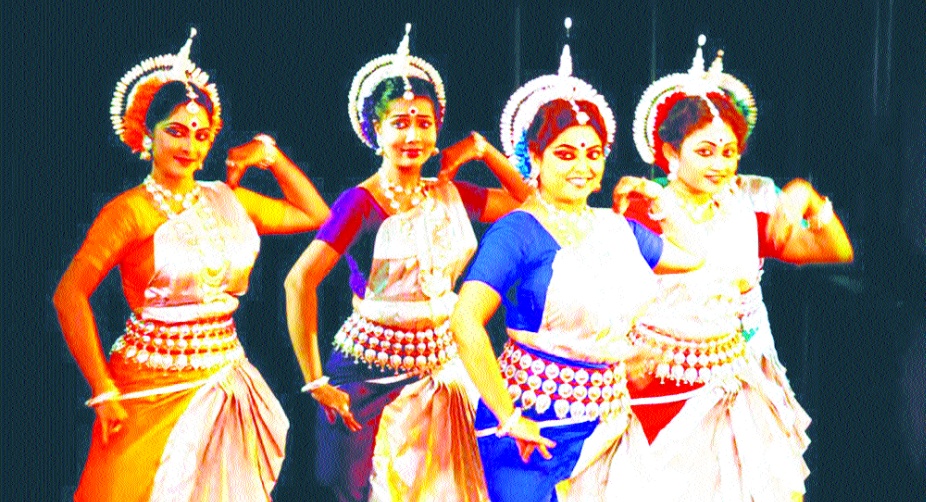Dance is my ‘swadharma’, expresses dancer Shallu Jindal
Classical dance teaches me every single day. It has taught me patience, commitment, discipline.
A unique evening of Odissi dance performances in Kolkata

The group called Odissi Forum is a collection of Odissi
practitioners who meet regularly to exchange and share the year long creative
work each one has produced. The forum provides opportunity to present a few
selected pieces of work either choreographed by them or by their illustrious
gurus. Or sometimes they perform long forgotten pieces and render gems from the
past, sweetly recalled from memory, producing great joy in the process.
Whosoever had conceived this unique concept needs to be congratulated. Other
Indian classical dance forms in Kolkata are catching on to the idea of a common
meeting ground to exchange views and present their art in myriads of ways in a
spirit of positivity.
Recently Odissi Forum celebrated their annual event at Gyan
Manch. Manipuri exponent Guru Kalavati Devi and Goutam De (regional director,
ICCR Kolkata) was the chief guest. The programme started on an auspicious note
with the first performer Labonyo Ghosh paying obeisance to the lord of dance,
who is possessed of many qualities and one who gives salvation to his devotees,
through the Panchakshara Stotram Nagendra Haraya penned by Adi Shankaracharya.
The piece in raag sohini and taal jyoti is a choreographic marvel by the iconic
Odissi dancer, late Srimati Sanjukta Panigrahi, the music for which was
composed by Pandit Bhubaneswar Mishra.
Soon after, Susmita Bhattacharaya’s students from her school
Kalakhetram performed Guru Vandana in raag malika consisting of raagas
bhairavi, bhairav, bairagi and darbari. This marvellous piece was by Ratikant
Mohapatra who has mastered the art of choreography. Bighnaraja composed the
music.
Advertisement
Singhendra Pallavi performed by Kakoli Bose was
choreographed to the music of Pandit Bhubaneswar Mishra in raag singhendra and
triputa taal. Debashish Sarkar sang raag kirwani in atatali taal, which won
half the battle for Maya Bhattacharya’s group Nrittya Sangam. Dwipannita Roy chose the abhinaya piece
Pasyati Dishi from Jaydeva’s Geet Govinda and emoted as best as she could.
A pallavi in raag saveri by the students of Diksha Manjari
was presented under the direction of Dona Ganguly. She delved deep into her collection
to choose this choreographic piece by Guru Kelucharan Mohapatra whose music
composition was by Pandit Bhubaneswar Mishra. There was good synchronisation of
movements and the ten girls who performed were quite a colourful lot.
Poushali Mukherjee’s presentation was again by the
choreographer-music composer duo of Kelucharan Mohapatra and Pandit Bhubaneswar
Mishra. Mukherjee’s disciples were all well-trained and danced with beautiful
aharya abhinaya. But the guru joining the students in the piece perhaps was not
a good choice to make.
Nilanjana Mukherjee chose Arabhi Pallavi choreographed by
Kelucharan mohapatra and her students of Behala Shinjini performed it with gay
abandon. Next up was Matangi Dhyanam by Shayomita Dasgupta with choreography by
Guru Ratikant Mohapatra in raag malika and taals, jyoti and aditaal — the
music was by Pradip Kumar Das. Possessed with a pleasant appearance, Dasgupta
delineated her story with the lovely movements that Odissi is known for. She
bowed to the lotus feet of bejewelled and bedecked Trinayani Matangi.
Priye Charushiley in raag desh and taal jhampa was performed
by Subikash Mukherjee. The particular piece from Geet Govinda needs a level of
internalisation, which takes one to the highest imaginable level where Krishna
declares Radha to be even more superior to him. On the surface it is the story
of a lover who has been disloyal and seeks to be forgiven and in the end
manages to melt his lady love but the allegory tells a different story. It was
choreographed by Kelucharan Mohapatra while music was by Pandit Bhubaneswar
Mishra. Mukherjee did justice to the piece but to master it takes a lifetime’s
work, where the bhakta has to grow spiritually.
Durga, by the students of Chhanda Manjari displayed the
multifaceted personality of the Goddess. It was directed by Rajneeta Mehra, who
was herself in the role of Durga. She has acquired a fair degree of the form’s
perfection. The choreography was by Kelucharan Mohapatra while the music was by
Debasish Sarkar. Megh Pallavi by Reshmi Basu was again choreographed by Guru
Keluchran Mohapatra while the music was by Pradip Kumar Das. Shabda Nrittya
performed by Krishnendu Roy and his group was choreographed by Sharmila Biswas.
The music of the piece was by Ram Hari Das — it was in raag shankara and taal
ektaali. Krishnendu Roy was in the lead role and the description of
Shankara-Shiva was done powerfully. The word sabda signifies sound and that was
displayed with a good sense of rhythm through yogic postures.
Joy Mahesh was a duet dance performance by Piyali Ghosh and
Riddhi Bhattacharya in raag malika and taal malika, choreographed by Ratikant
Mohapatra accompanied by the beautiful vocal rendition of Debisis Sarkar.
Dashavatar, which had earned instant acceptance and appreciation by all
rasikas, a one-of-its-kind choreographic work by Guru Kelucharan Mohapatra, was
performed by Amrita Das and group. The out-of-the-world music for the piece was
by Pandit Raghunath Panigrahi.
Rajib Bhattacharya who has dedicated his life to Odissi presented
his students from Srijan Chhanda in the grand finale of the evening. Moksha or
salvation as the word means is what dance yoga is supposed to bring to a
practitioner. Guru Kelucharan Mohapatra is the choreographer and the composer
was again Pandit Bhubaneswar Mishra.
One noticeable fact of Shraddhanjali was that none of the
aspiring dancers or mentors presented their own choreographic work. Of the 15
performed, almost all were choreographed by the legendary Guru Kelucharan
Mohapatra.
Advertisement